Tomatoes sometimes develop an initial light brown spot or a black spot at the blossom end of the fruit. These brown spots develop for several reasons, so understanding the reasons is crucial, as it is essential to get knowledge about the same for both the gardeners and consumers.
These brown spots are indeed concerning, and understanding them will help you take appropriate measures to prevent and manage the issue.
Let us take a deep dive and explore the causes along with the preventive measures and look forward to a healthy harvest.
Why Do Brown Spots Develop On Tomatoes?
Table of Contents
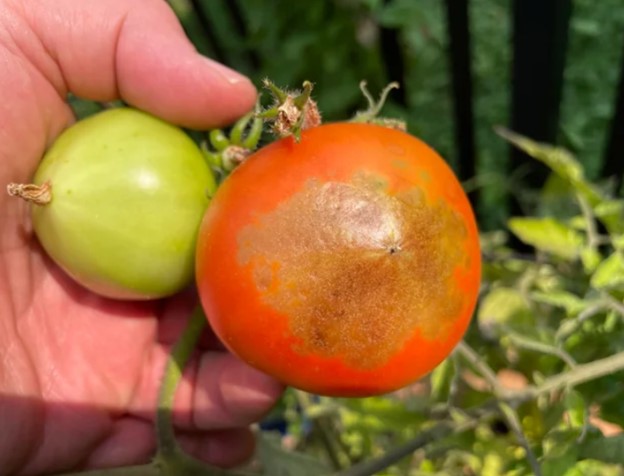
Brown spots arise from different issues, and some of the common reasons are discussed below:
-
Blossom End Rot
Blossom End Rot indicates dark spots at the blossom end of the fruit and is known to be caused due to a deficiency of calcium. These dark, sunken spots are at the bottom of the fruit. In some cases, the dark brown spots expand, thereby making the tomato unusable. This is one of the most common causes of brown spots on tomatoes.
-
Fungal Infections
Early Blight is a fungal disease that affects tomato plants and starts developing on the older leaves of the plant. Slowly it spreads to the stems and fruits and appears as sunken lesions and generally appears as concentric rings.
Late Blight affects the leaves and fruits and spreads through rain, water splash, and wind. They develop as dark-colored spots on the leaves as well as the fruits.
Septoria Leaf Spot is another fungal disease that develops into small dark brown spots on the center of the leaves in the beginning but later spreads on the fruit.
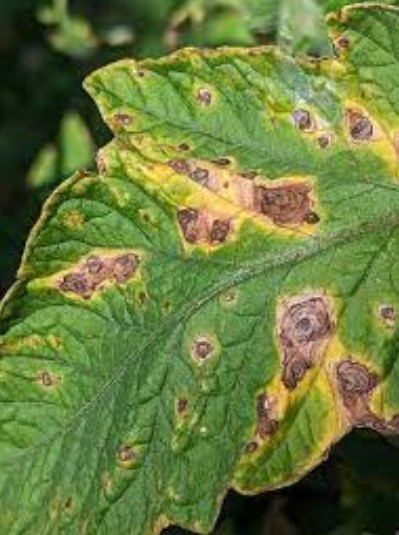
-
Sunscald
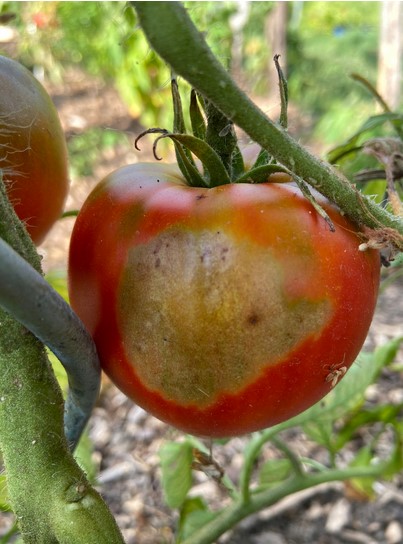
Direct sunlight causes sunscald on tomatoes, and eventually, the affected area develops brown, leathery patches as the tissue starts breaking. This generally happens when the fruit gets exposed to direct sunlight for a prolonged period.
-
Insect Damage
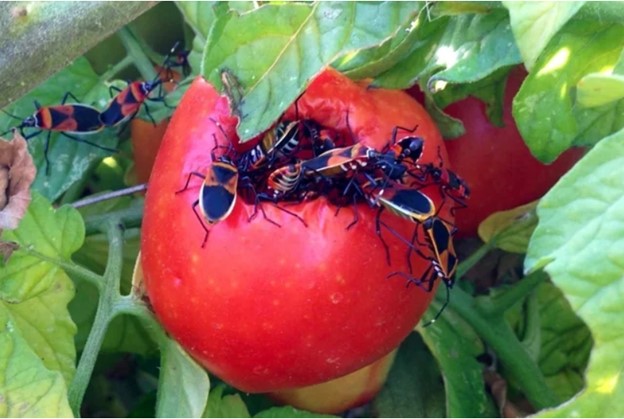
If insects such as stink bugs or fruit worms feed on the tomatoes, they puncture the skin, and later on, the damaged area turns brown and hardens. Pests such as tomato hornworms, aphids, and whiteflies damage the fruit and thereby lead to brown, sunken spots on the fruit.
-
Nutritional Deficiencies
Certain nutrients, such as potassium or magnesium, lead to brown spots along with discoloration on leaves and fruits. The deficiency of certain nutrients turns the leaves yellow, which in turn affects the development of the fruit and leads to brown spots.
-
Physical Damage
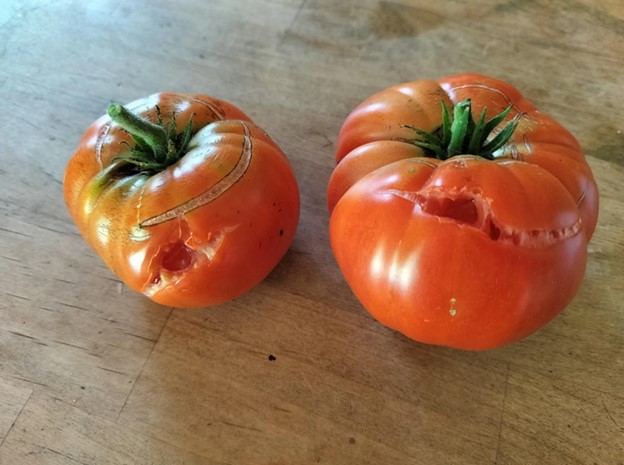
Sometimes physical injuries on tomatoes, such as bruising or rough handling, also result in brown spots. These spots are nothing but mechanical stress on the fruit.
-
Overripe Fruits
Overripe tomatoes are very susceptible to diseases or decay. They tend to develop brown spots if they are exposed to adverse weather conditions or kept on the vine for too long.
-
Improper Storage Techniques
Storing tomatoes improperly will lead to brown spots, as certain conditions, such as high temperature, direct exposure to sunlight, or poor air circulation, develop brown spots that eventually lead to discoloration and decay.
How Can I Prevent Brown Spots On Tomatoes?
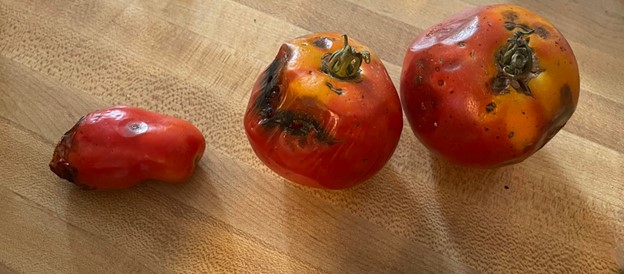
By following these preventive measures, you’ll be able to reduce the risk of brown spots on tomatoes:
1. Consistent and Adequate Watering Techniques
Watering the plants consistently and maintaining a regular watering schedule will help prevent certain fungal diseases like Blossom end rot, Early blight, and Septoria leaf spot. Also, watering at the base will keep the soil moist, help prevent fungal diseases, and maintain a flow of steady and healthy nutrients.
So, all you need to do is master the watering techniques and allow yourself to enjoy healthy, spot-free tomatoes throughout the season.
2. Mulching
Applying an organic layer of mulch around the tomato plants will help the plant retain moisture and therefore prevent soil-borne pathogens and reduce the risk of the emergence of brown spots.
Applying organic or inorganic material around the plant will also create a healthy growing environment and ensure a steady supply of nutrients to the plants.
3. Adding Calcium
Consider adding sufficient calcium to the soil in the form of crushed eggshells, agricultural lime, or bone meal to boost the calcium levels. Proper and adequate calcium levels ensure that the fruits remain spot-free, as they play a key role in the overall health of the tomato plants.
4. Improving Air Circulation
Ensure there is proper spacing around the plants to allow a sufficient amount of air circulation, as a warm environment is responsible for fungal infections that result in dark brown patches.
Better air circulation reduces the chance of fungal diseases as it lowers the humidity around the plants overall, leading to healthier and nutrient-rich fruits.
5. Avoid Overhead Watering
Avoid watering the leaves of the plants, as it leads to fungal diseases. Wet leaves are known to promote fungal infections, so it is advisable to water the base of the plants.
By avoiding over-watering, you’ll be able to reduce the chance of blossom end rot, which is known to cause yellowing of leaves, stunted growth, or brown spots on the fruit. So, strike the perfect balance and create a healthy environment for your tomato plants to thrive.
6. Protecting From Excessive Sun Exposure
Excessive exposure to the sun results in sunscald, so it is essential to cover the plants with adequate leaf cover by using a cloth shade during extremely hot days. Too much exposure to the sun results in brown spots and other issues, so if you need blemish-free fruits, then protect the plants from the harsh rays of the sunlight and reap a bountiful and quality harvest.
7. Applying Fungicides
By applying fungicides, you’ll be able to prevent and treat the brown spots on tomatoes, as they are known to stop the spreading of fungal infections from reaching the fruit and then causing the brown spots. It therefore acts as a protective barrier and preserves the plant’s health.
8. Crop Rotation Techniques
Crop rotation is another important technique for fixing the brown spots on tomatoes, as it improves the health of the tomato plants and also reduces the risk of soil-borne diseases such as early blight, late blight, and Septoria leaf spot. Crop rotation techniques also improve the soil structure and reduce the microbial activity that is especially conducive to plant diseases.
9. Using Organic Treatments
Applying organic fungicides that contain copper or potassium bicarbonate will act as a preventive measure against certain fungal diseases and therefore reduce the risk of brown spots on tomatoes. Regular application of organic fungicides reduces the appearance of brown spots and also supports the overall health of tomato plants.
10. Soil Health Management
Also, using a high-quality potting mix or well-drained garden soil will play an important role in enhancing the structure and nutrient content of the soil and also prevent the issue of brown spots on tomatoes. Proper pH balance in the soil prevents blossom end rot and brown spots that are mainly caused by nutrient imbalances or disease stress.
So, managing soil health will ultimately reduce the likelihood of brown spots and promote overall plant health.
Bottomline
Brown spots on tomatoes are disheartening for gardeners but can be prevented with the right amount of care and attention. By taking certain proactive measures, you’ll be able to keep the tomatoes blemish-free.
So, go ahead and put a little extra effort into keeping your tomatoes spot-free.
Leave a Reply